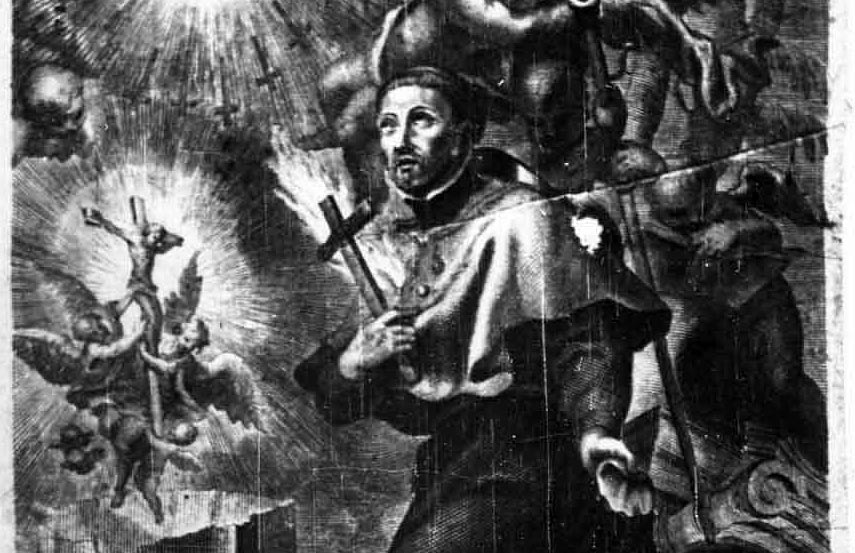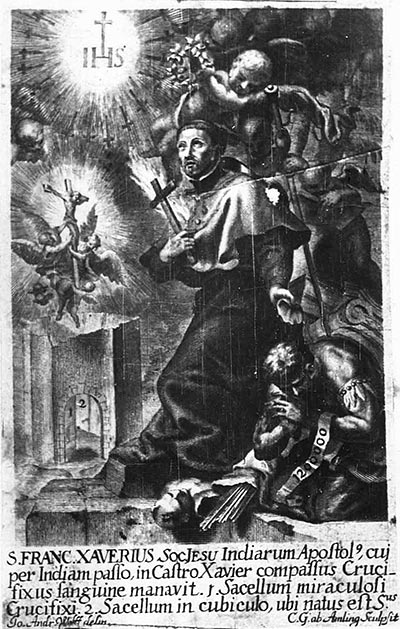A couple of 17th century images of the castle of Javier (II)

PhotoCedit/Engravingof St. Francis Xavier and the castle by Karl Gustave Amling. St. Xavier, Schurhammer Fund, detail.
Another picture with the saint and the castle as protagonists.
In the iconographic collection compiled by the great biographer of Xavier, Father G. Schurhammer, there is a photograph of a burin engraving opened at the end of the 17th century by Karl Gustave Amling (Nuremberg, 1651-1702), who perfected his art in Paris, on a drawing by the painter Johann Andreas Wolf (Munich, 1652-1716).
The saint adoring the name of Jesus in a solar halo takes centre stage. Saint Francis Xavier is dressed in a pilgrim's habit, wearing a flaming heart and carrying his usual attributes: the missionary's cross in one hand and the baptismal conch in the other. Angels crown him and hold the staff, while a kneeling infidel prepares to be baptised, without missing a phylactery that tells us of the thousands and thousands of leagues that the saint walked in his apostolic endeavours. At his feet is a smashed bust of a deity of the gentiles, to insist on the true doctrine preached by Xavier and his triumph. From the sun alluded to with the anagram of Christ depart numerous crosses that make reference letter to the hardships he was to undergo in his work in the missions, and this is not exclusive to Saint Francis Xavier, as Gabriela Torres Olleta has pointed out in her iconographic study of the Navarrese saint. In the case of Xavier, the scene would have taken place in the hospital in Venice in a heroic act with a poor sick man, when Xavier had to overcome himself. It was then that the Lord showed him countless crosses as sample for the labours he was to suffer in the Indies, at which Javier exclaimed: "More, more, more Lord". From that passage onwards, crosses would appear next to Xavier in various iconographic types.
In front of the figure of the Jesuit saint, there is a large tower with the figure of the miraculous Christ carried by angels who seem to carry and carry the image of the Crucifix. Inside the building there are two numbered rooms corresponding to the holy chapel and chapel of the Holy Christ.
The registration in the lower part gives a good idea of the purpose of the print, highlighting the saint as the apostle of the Indies and the miracle worked by the Christ of Xavier, who is depicted in a large miraculous halo of light. We have already dealt with the holy chapel in the previous example. Regarding the Christ, we must remember that the legendary account of everything that happened with the venerated image and the Jesuit saint is already recorded in 1586 in a report which reads: "It is considered very true that he was seen sweating every Friday of the year that Father Francis Xavier died: and he began to perform this miracle on a Friday at nine o'clock at night: and this is known to very important and true people". Other testimonies insisted on this miraculous event during the 17th century. Thus, Trigaultius, author of the Vita Gasparis Barzaei ( Antwerp, 1610) states that, on his visit to the Castle of Xavier in 1606, he heard the tradition of the blood sweat from servants worthy of faith and from Xavier's heir. After studying the matter critically and excerpting the story he found "that it was a family tradition propagated to posterity not so long ago as to be obscure".
Other sources closer to the making of the engraving insist on the same. Thus, we know that Don Joaquín de Huesa y Agüero, an infanzón of Sos, ordered in his will, in 1671, the foundation of a Jesuit house in that Aragonese town "in obsequio y culto del glorioso Apóstol de las Indias San Francisco Xavier por ser vecino y natural de aquella tierra y venerarse en el Castillo llamado de Xavier distante una legua corta de dicha villa de Sos así la pila donde el Santo fue bautizado como una efega de la Apóstol de las Indias San Francisco Xavier. Saint was baptised as well as an effigy of a Crucifix that according to ancient tradition sweated whenever the Saint suffered great labours in East India and the other Kingdoms of Japan where his apostolate took place and in the year in which the said holy apostle died he also sweated blood every Friday of that year". Father Raimundo Lumbier, a Carmelite priest born in Sangüesa, in one of his works, published in Zaragoza in 1678, reaffirmed the same data.
These intaglio prints were not the only ones showing the castle with the Holy Christ and the abbey. A small engraving signed by J. Lenoir, more popular than the previous ones and without the figure of the saint, sample the keep with Christ carried by the angels against the background of the Pyrenees.

Engraving of St Francis Xavier and the castle by Karl Gustave Amling. St. Xavier, Schurhammer Fund
To find out more
FERNÁNDEZ GRACIA, R., San Francisco Javier Patron Saint of Navarre. Fiesta, religiosidad e iconografía, Pamplona, Government of Navarra, 2006.
FERNÁNDEZ GRACIA, R., El fondo iconográfico del P. Schurhammer. La report de Javier en imágenes, Pamplona, Chair de Patrimonio y Arte Navarro, 2006.
FERNÁNDEZ GRACIA, R., Image and mentality. Los siglos del Barroco y la estampa devocional en Navarra, Madrid, Fundación Ramón Areces, 2017.
TORRES OLLETA, G., Redes iconográficas: San Francisco Javier en la cultura visual del Barroco, Pamplona, Universidad de Navarra - Madrid, Iberoamericana, Frankfurt am Main, Vervuet, 2009.
